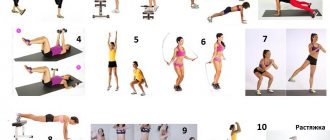How to learn to do pull-ups and not give up this useful exercise
Pull-ups are an amazing element of training. This is a powerful weapon for increasing endurance, strength, muscle stretching, as well as developing joints, strengthening tendons and many, many other factors for improving human biomechanics.
But during pull-ups, you can also give additional load by changing the width of the grip, the intensity, the variability of the pull-ups - at least with one hand, rush to the bar, at least hang additional weight on the body (there are special loading vests with sand or belts for additional weight) - always you can find an approach to complicate it. In general, a comprehensive complex is more productive than any fitness room with newfangled exercise equipment.
Perhaps this is all due to the fact that, according to many professional athletes, as well as physiologists and anthropologists, it is precisely this movement - pulling up with arms - that is one of the most natural, fundamental and ancient. It was with the help of its use that our very distant ancestors obtained food for themselves and escaped from predators. Alas, for many living Homo sapiens, upward movement has long ceased to be familiar and understandable...
Pull-ups have become an impossible task for many. Why?
photo: www.flickr.com
And what did we come to in the end, after hundreds of thousands of years of evolution? And to the fact that even children have lost the ability to perform this training element, despite the fact that previously at school there were no big problems with pull-ups among boys. Today, children are sometimes unable to do pull-ups even several times. We're not talking about the correct pull-up technique. You can blame anyone and anything for this, but everyone agrees with the root of the problem: the sedentary lifestyle of a modern person, lack of athleticism and excess weight.
The latter fell a special burden on the shoulders of the older generation. Starting from adulthood and further, at 25, 30, 35 years old, citizens all over the planet, including Russia, are overweight, sometimes turning into one of the stages of obesity. So it turns out that one drags on the other. Fat accumulates in the body due to lack of exercise, and starting to exercise with excess weight is difficult and simply dangerous to health (excessive stress on the heart, joints and other organs and groups of organs will not add positive emotions).
80% of gym goers cannot do five pull-ups!
But even if you are not overweight, it is not a fact that pull-ups will be easy for you. Moreover, paradoxically, ask trained people lifting weights in the gyms of fitness centers to do 10 pull-ups, and 70-80% of them will not be able to do even half of this number. What's the matter? How does this happen?!
Pull Up Program: What You Need to Know
There are a large number of methods and schemes that allow you to increase the number of pull-ups over a certain period of time. The pull-up program below is for ten days.
The essence of the technique is that you need to work with rest every ten days so that you do not lose interest in the exercises. Thanks to it, you can improve your results several times, which is especially good for beginners.
The program is broken down into three different levels depending on the athlete's skill level. The first level is designed for beginners who cannot do more than five pull-ups. The second level is for those who can do 5-10 pull-ups, and the third level is for more experienced athletes who can do more than ten pull-ups.
The entry level assumes that you will need to do pull-ups 30 times every day, dividing your workout into a large number of approaches. At the second level, the daily number of repetitions approaches fifty, and at the third it increases even more.
Do pull-ups the required number of times throughout the day. You need to repeat this for ten days, and then take a break of 3-4 days. After resting, you can increase the number of pull-ups you do, and your results will improve every ten days.
The problem with pull-ups is in our heads
photo: www.flickr.com
No more, no less. Yes, pull-ups are a complex exercise that loads the entire body as a whole with a one-time and extremely high load. If 10-15 years have passed since the days of your school desk and you have not approached the horizontal bar all this time, you will be surprised how much your hands become clogged as soon as you hang on the horizontal bar. Even a normal hang (without trying to pull yourself up) for 10-15 seconds will at first seem like torture, and your fingers will spontaneously let go of the bar.
Once you start trying to do pull-ups, you will be even more amazed.
No, your biceps, triceps, pectorals and back will not get tired - they just won’t have time. But, most likely, your fingers will begin to hurt unbearably, your forearms will instantly get tired, aching joints will appear, pain in the tendons will make itself felt, and so on and so forth. In this mode, it will be simply unrealistically difficult to train. see also
10 simple exercises to keep your legs in good shape: 20-minute workout
And even when the workouts become normal, and the muscles and body get used to the new load and it seems that the hardest part is behind us, most of us, over and over again, without even realizing it, will delay the transition to performing a set of pull-ups in their daily workouts. Do you know why this happens? Now we will try to explain.
"Predisposition" to pull-ups
There is a popular belief that some people are simply “not born” to do pull-ups. There are clearly more than half of them even among athletes, and it is indeed very difficult for them to master this important element of training.
They try to explain the phenomenon by the presence of various factors - from physiological characteristics to age and even gender. It is believed that it is often more difficult (literally impossible) for women to master this type of training. Then how to explain records that are not set by professional athletes?
First motivational story
One of the most striking examples is the record of Australian Eva Clarke. She did 725 reps in an hour, completing 2,749 pull-ups in 12 hours and 3,737 sit-ups in 24 hours! Let us especially emphasize: Eva is definitely not a pro, she has three children, and she set the record at an “advanced” age for athletes - at 36 years old!
How do you like this? Do you still want to look for reasons why you can’t do those worthless 10 pull-ups per set? Despite the fact that for some people pull-ups will be easier, for others it will be more difficult, but I think absolutely everyone can do the repetitions up to 27-30 times per set.
Therefore, we dismiss the statement about a predisposition to pull-ups as untenable.
Attention! The only exception here would be regarding age. Not to mention the elderly, mastering the element of sports training will be very difficult for a 50-year-old person, and excessive exercise can aggravate old injuries or health problems! Before you start exercising, consult a medical professional.
Which type of beginner athlete will find it easier to do pull-ups?
Everyone’s body constitution is different – it’s a fact, and the preparation, if we’re talking about citizens who don’t shy away from sports, is also different.
photo: www.flickr.com
For example, athletes who have a developed upper body muscle frame with relatively low weight (for example, skiers and track and field gymnasts) usually have an easier time doing pull-ups than cyclists or speed skaters, who mostly develop their legs.
It is important to realize this inexorable fact. Therefore, if your path is to run in the morning and one fine day you decide to start training on the horizontal bar, know that you will not be able to pass the Airborne Forces standard right away.
And on the contrary, if you have been working out in the gym for several years, if you are familiar with dumbbells, barbells and exercise machines, it will be much easier for you to become a turnstile man - by this time you will have developed the main muscle groups of the core, and the matter will remain up to you small ones - to develop auxiliary traction elements for productive and technically correct pull-ups.
Conclusion: developed upper body muscles are good. Pumped up legs won't help here. Before starting training, you need to lose as much excess weight as possible - it will only get in the way.
Second motivational story
Marine Lieutenant Misty Posey is further proof that if a man puts his mind to it, he can learn to pull himself up. Posey, who had never played sports before joining the infantry, was forced to learn how to do pull-ups out of necessity.
The US Marine Corps did not include pull-ups in its women's physical fitness test until 2021, but the obstacle course did. During her service, she, like everyone else, had to overcome it. The obstacles were of different heights, and the tallest of them could not be overcome by the short Misty in any other way than by pulling herself up.
The woman spent almost a year trying to go from zero to one pull-up on machines, but it didn’t help: despite the progress in training in the gym with “iron friends,” when it came to the horizontal bar, the result was near-zero.
As a result, one sergeant, seeing Posey’s futile efforts, advised her not to torture the machine (it was a waste of time), but to go to the horizontal bar and start working out on it, but in a smart way.
1. Advice to start with jumping pull-ups (in English they are called “jumping pullups”):
2. And half pull-ups:
The advice was so simple that she almost rejected it, but it ended up working. Three days later, the lady did her first pull-up, and there were more to come.
Types of pull-ups on the bar
There are several types of pull-ups on the bar. In many ways, the technique for performing them is similar, but still, there are some differences.
High bar pull-up
The most common is a full-range pull-up on a high bar. But not all people who have come to sports relatively recently find this exercise easy. Poor stretching of all ligaments and muscle fascia, low tone of the back muscles, weak grip and hypertonicity of the lower back muscles, accumulated over years of office work and a sedentary lifestyle, have an effect. Therefore, first you should master one simpler way to do pull-ups: hanging pull-ups while lying on a low bar.
Low bar pull-up
Low bar pull-ups are an easy way to master proper pull-up technique. To perform it, we will need a horizontal bar with height adjustment or any other similar equipment (for example, TRX loops or an Olympic bar and squat racks). Fix it at approximately chest level, bring your legs slightly forward, they should be slightly bent at the knees. The angle of inclination of the body should be approximately 45 degrees, we try to keep our back straight at all times, our gaze directed forward. The more you move your legs forward, the longer the range of motion will be and the more load you get on the latissimus dorsi muscles.
When performing pull-ups lying on a low bar, try to work at the fullest possible amplitude, touching the bar with your chest and statically straining the latissimus dorsi muscles at the top point of the amplitude. In the negative phase of the movement, try to go down as slowly as possible - this will load your back muscles even more, and your strength will increase.
When you have perfectly mastered the technique of hanging pull-ups while lying on a bar, start trying to perform pull-ups on a high bar. It's okay if you don't succeed the first few times. The main thing is to try to do a little more with each workout than you did in the next one, then progress will not be long in coming.
Pull-ups with different grip widths
We recommend starting with a grip approximately shoulder-width apart - this will help you feel the contraction and stretch of the latissimus dorsi muscles more easily, but then you can vary the grip width from very narrow to wider than shoulder width. This kind of complex exercise, done from different angles, allows you to work all the muscles in your torso. The narrower the grip, the more the biceps and lower part of the latissimus muscles are involved in the work; the wider, the more the rear deltoids and trapezius muscles work.
Preparatory exercises for pull-ups
From here we draw the most important conclusion: if you want to learn how to do pull-ups, immediately start training on the horizontal bar and use “cheating” or training exercises.
Why is it important?
photo: www.flickr.com
1. As we said earlier, pull-ups involve numerous muscle groups, as well as poorly trained parts of the musculoskeletal corset, including such specific structures as tendons and joints.
They can only be pumped on a projectile and only under the load that is natural in this case.
2. Don't start your workout by trying to do a full pull-up right away. This is unlikely to lead to results, and you will not master the correct pull-up technique, which will require further adjustments to the training process. Relearning in itself is more difficult than learning correctly right away - you simply won’t understand what you’re doing wrong, which means you’ll do the wrong exercises on the horizontal bar until your mistakes are pointed out to you.
3. There are actually quite a few options for lead-up exercises. They can be done either independently or with the help of a training partner. Their main task is to unload the hands and allow the muscles to get used to the load.
The most common options (medium grip, palms facing away):
Risks and contraindications
As with many basic movements, pull-ups on the bar simultaneously work several joints (shoulder, elbow), a large number of ligaments and muscles.
The complexity of the movement and the force-oriented nature of the load create the preconditions for injuries, but only if the correct technique is violated.
To minimize the risk of injury, do a pre-warm-up, focusing on warming up your shoulder, elbow and wrist joints. As well as light dynamic stretching of the muscles and ligaments that receive the movement.
Among the contraindications to performing pull-ups on the bar are:
- Diseases or injuries of the shoulders, elbows and hands (arthritis, arthrosis, bursitis, etc.)
- Injuries to muscles and ligaments involved in movement
- Heart disease and high blood pressure
Correct technique for pull-ups on the horizontal bar
photo: www.flickr.com
Grasp the bar firmly with your little finger on the top of the bar. The thumb is to clasp it from below. That is, the grip is closed, not open - when the thumb is on the side and you actually hang on four fingers.
Tighten your pelvis and tighten your abs. Lower your arms and keep your shoulders as low as possible.
The legs should hang perpendicular to the plane of the ground, the head should be straight (do not throw it back or lower it), and look forward.
When starting the exercise, tighten your abs and buttocks and concentrate on pulling your elbows toward your ribs, trying to tuck your chin over the bar. At the same time, there is no need to raise your chin up - this is psychological self-deception.
Video taken from the YouTube channel “ANDREY FILIPOV”
Try to do the exercise with smooth movements, without jerking or haste. It is especially important to do a measured descent from the top point, best loading the torso muscles without overload and possible injuries (dislocations and sprains).
You should also not “undermine” yourself by pushing yourself with a short powerful upward movement, even when you are tired. Although this is an option - to complete the required number of approaches at the end, you can get used to such cheating, and now you are constantly doing jerks when doing pull-ups. You won't have time to blink your eye!
But such a sudden movement is dangerous to health! In a fit of stretching, throwing their head back and sharply lifting their chin, they squeeze their shoulders, which has the most negative effect on the spine, literally compressing it in some places. If you do the approaches incorrectly over many years, eventually even intervertebral hernias may appear in these places. And instead of health, disability may well appear.
It’s better to do this: tired, can’t make it? Fix the position on bent arms where you have reached - and smoothly down, jump off and rest. No half-measures, swinging, trying to get your chin over the bar with the help of uneven bending of your arms, and so on - this is prohibited, do the exercise correctly, it will pay off handsomely.
What should you definitely remember?
- Don't let your body sway while doing pull-ups, learn to control it;
- Perform the exercise smoothly and slowly, without jerks or sudden descents;
- Try to stretch your chin up. The exercise is considered completed when the chin is above the horizontal bar;
- Breathe evenly, watch your breathing. When you stretch up, exhale, while lowering, inhale;
- Hold on to the horizontal bar tightly. If your hands sweat, use sports magnesium (it can be replaced with chalk, talcum powder and even starch);
- Complete the exercise before muscle failure occurs. During pull-ups, it is important to monitor the technique of performing the exercise. If you feel that you are no longer lifting high enough, you are starting to pull yourself up crookedly, or you are slowing down, it’s time to end the exercise;
- Don't perform the exercise by always using the same grip. Any new load is stress for the body, giving a signal for the beginning of muscle growth. However, if you always use the same grip, the muscles get used to such a load and, as a result, stop growing. Therefore, try to change your grip or grip width every one and a half to two months;
- Vary the number of sets and reps per set to keep your muscles from adapting and stopping growing. You can alternate training with a high number of repetitions, aimed at increasing endurance, with training with a low number of repetitions, but with weights - to increase strength;
- Use an expander to strengthen your grip and make your hands stronger;
- Give your muscles enough time to rest and recover, don't overload them every day. Ideally, you should do two to three workouts per week;
- If you are just learning how to do pull-ups, do not use a wide grip, as it is considered the most difficult;
- Do not jerk your head back when starting to move your torso upward, so as not to injure the cervical vertebrae;
- Don't arch your back. Many people do pull-ups with an arched back, but this can be dangerous. To fix your back in the correct position, tense your stomach as if you were about to be hit;
- Squeeze your hips and squeeze your buttocks - this will allow you to sway less.
Correct breathing technique when doing pull-ups
photo: www.flickr.com
Before pulling up, take a deep breath, holding your breath;
While performing the exercise while lifting, hold your breath until your chin or (in a more advanced version) chest reaches the bar;
Exhale as you lower. Smooth and measured. We repeat in the same sequence.
Common mistakes beginners make when doing pull-ups
You know how to do pull-ups on the horizontal bar for beginners, and you can start training. However, it is worth considering common mistakes that beginners often make in their first lessons.
- When doing pull-ups on the horizontal bar, you should only use your upper body . The legs should be calm, no effort is required from them. Beginners often sin with this, trying to climb onto the horizontal bar so that their chest finally rises above it. They swing their legs and give impulse to their joints, thus rising to the top, but this is fundamentally wrong. Pull-ups are only effective if they are done exclusively using the muscles of the arm and back. Moreover, the back works first, when you bring your shoulder blades together and thus provide the necessary tension, and then the arm muscles, through which the body is pulled upward.
- A very common mistake is sudden movements. Beginners often make careless sudden movements, especially when going down, or rather, as if falling down. This is not correct. In order for muscles to build correctly, the muscles must work as hard as possible, and with sudden movements you, on the contrary, free yourself from the load, and also increase the risk of injury. All movements must be smooth and accurate. You need to rise and fall in the same rhythm.
- Another shortcoming that is often found among those who are just mastering the horizontal bar is straightening the elbows completely , which most often occurs when lowering the body. Please note that the load on the elbow joints during the exercise is very strong, so you cannot straighten them completely either when ascending or descending - otherwise there is a considerable risk of injuring the elbow joints.
- Don't aim for an intense pace. Fast does not mean good, especially if you have just started training. You can do pull-ups many times in a minute, but the muscles will receive minimal load; accordingly, efficiency is significantly reduced, but the unwanted load on the joints increases. When pulling yourself up, don't rush . Do the exercise slowly, smoothly, consistently, feeling how the muscles of your back, arms, and shoulders tense.
- Improper breathing is also a common mistake. Beginners, who find it difficult to do pull-ups due to lack of experience, often involuntarily hold their breath, breathe quickly, lose the correct rhythm, but this should not be done. Breathe smoothly and measuredly, rising as you exhale and descending as you inhale.
- Another point is neck tension. In any case, the neck muscles will strain when pulling up, however, the main load should not be placed on them. First of all, the back, arms and abs work, and there is no need to transfer their load to the neck. Control your movements so as not to overstrain your neck muscles and cause injury.
- Don't rush into weights. Many athletes who have already mastered standard pull-ups increase the load using special weight vests, belts, and plates. But this can only be done if you are fluent in the technique of doing pull-ups with your own weight.
How to jump on and off the horizontal bar?
What would seem simpler? You jumped up and there you were, hanging! Not really an obvious fact. With the same chance, you can lie under the horizontal bar when your hands slip or one of them misses the iron stick.
This is an inevitable injury!
Therefore, it is worth paying close attention to a number of factors:
1. Height of the horizontal bar. The horizontal bars can be divided into three groups according to their height: low – 1.5 meters, medium – 2 meters and high – about 2.5 meters. Let's assume your height is 180 cm. In this case, a medium-height horizontal bar will suit you, and not the highest one, since when you try to catch the bar from a jump, you may fall. The same is true for shorter people, only in relation to the average horizontal bar.
photo: www.flickr.com
2. A wet, slippery horizontal bar is a dangerous horizontal bar. When training after rain or in winter, be sure to wipe the equipment before use. Otherwise, at the moment of catching, your hands can easily slip and you will end up on the ground.
3. You cannot jump onto the horizontal bar with a running start, trying to grab it in flight. Looks impressive, but leave the stunts to the stuntmen.
How to do pull-ups correctly: basic rules
Learning how to do pull-ups on a horizontal bar is not that difficult. If you succeed, you will be able to effectively work out different muscle groups, in particular the muscles of the back and shoulder girdle. The latissimus, teres, and trapezius muscles work on the back. The chest is fully involved, as well as the biceps, triceps, deltoids, and forearms. Even the press is involved in the work, which acts as a stabilizer, fixing the static position of the torso.
Correct pull-ups on the horizontal bar require the following nuances :
- You must control your body completely. You need to pull yourself up using the strength of your muscles, without helping yourself by swinging or kicking.
- You need to lift your body smoothly , avoiding jerks and abrupt movements.
- During the exercise, you need to pull your chin. If a full pull-up is done rather than a partial pull-up, it should rise above the bar.
- After pulling up, there is no need to sharply lower your body down. You must do everything smoothly. The descent should take the same amount of time as the ascent.
- Proper breathing is very important when doing pull-ups on the horizontal bar, the basics of which we will look at below.
- Hold the bar firmly.
- The body should not hang crookedly. It should be straight, like a string. A slight arch in the back is allowed.
These are just general rules, and for each type of pull-up there are a number of recommendations. Next, let's look at what types of pull-ups there are.
How to jump?
You let go of your hands, and that’s it – are you on the ground? Not really. With a sloppy landing, your spine will receive overload and significant stress. Again, the higher the horizontal bar, the greater the speed you will be able to develop when jumping, the greater the load will be.
This means you need:
1. Use a horizontal bar according to height;
2. Group yourself before jumping: your legs are slightly tense - you will use them to absorb shock. We release our hands and, upon contact with the surface, squat a little on our feet, absorbing inertia and maximally removing the load from the spine.
No landings on straight legs and without shock absorption by them. Otherwise, if you have problems with the spine (osteochondrosis, intervertebral hernia, etc.), you will only aggravate the situation. And as we remember, many people have problems with the spine these days.
see also
Weight loss with running and walking: how long will it take to burn calories from your favorite foods
Therefore, in order not to cripple your pillar of life, first practice jumping and landing correctly or select horizontal bars to suit your height.
How not to give up on pull-ups?
In general, we have considered all the nuances of working with a horizontal bar. But since many people associate pull-ups with great difficulties and psychological overcoming of oneself (and for many, these associations do not go away even after years of seemingly fruitful training on the bar), each time some athletes try to put off this element of training for later, slightly delay it or they do it without enthusiasm.
photo: www.flickr.com
As a result, sooner or later they give up pull-ups. How to motivate yourself?
In our opinion, there are at least two effective methods:
Competitive passion: try to set goals for yourself and try to achieve them, and to make this more effective, find yourself a sports companion, preferably of the same level. By pushing each other together, you can achieve significantly better results.
Diversify your pull-ups, learn new variations. Pull-ups are an endless source of new discoveries. You can change grips:
Neutral grip; Reverse grip; Wide grip; Straight or reverse narrowed grip; Parallel grip; One-arm pull-ups; Archer pull-ups and so on...
You can do pull-ups with weights. You can do pull-ups measuredly, slowly or intensely (however, the pull-up technique should not suffer). You can do pull-ups on various types of horizontal bars, you can include acrobatic elements if you think you’ve reached this point... The variety is overwhelming! And in the end, the horizontal bar will give you a beautiful, slender body, endurance, posture and the understanding that you are better than many athletes around! And all this is free. There is a horizontal bar in every yard!
Collage cover: www.flickr.com











